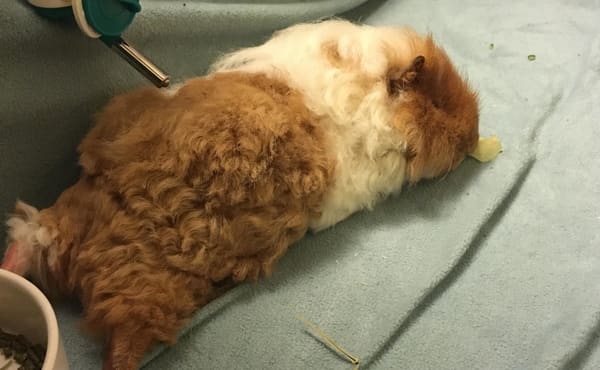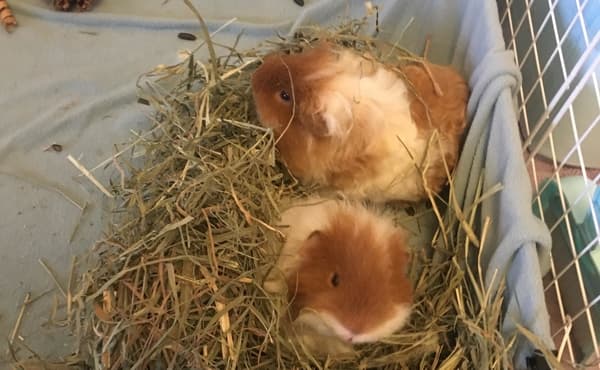In order to stay healthy, a guinea pig needs to eat hay daily. Their hay intake is responsible for the fiber and nutrients in their diet, and typically they can only go 24-48 hours without it.
So, why won’t my guinea pig eat hay? There are two main reasons that could be causing your guinea pig not to eat their hay including dental disease or a potential problem with their hay.
In this article, we’ll talk about why your guinea pig might not want to eat, as well as the different issues that may be happening with your hay. We’ll also cover some ways to help your furry friend, so you can make sure they’re healthy and happy!
Dental Disease
A possible cause of a guinea pig losing interest in eating their hay is dental disease. Guinea pigs’ teeth grow continually throughout their lives. One reason hay is so important for guinea pigs is because chewing it files their teeth down.
Dental disease happens in guinea pigs when their teeth overgrow, abscesses (pockets of pus in the mouth) form, and from sharp spots of teeth that create sores in the pig’s mouth or tongue. If your guinea pig is suffering from a dental disease of some kind, they may lose interest in hay due to the pain of chewing.
Symptoms of Dental Disease in Guinea Pigs
Dental disease can be hard to spot at first, but there are a few key symptoms to keep an eye out for in your pet. To spot dental disease in your guinea, watch for these signs:
- Not eating
- Only eating soft food
- Losing weight
- Drooling and extra saliva
- Increased vocalizations and noises
- Muscle weakness
- Swelling in the face
Dental disease is diagnosed through oral examination and sometimes x-rays. If you suspect your guinea pig may have dental disease, contact your local veterinarian immediately. Dental disease can lead to respiratory infections and even death.
Treating Dental Disease in Guinea Pigs
Mild cases of dental disease are often treated by giving your guinea pig more hay and grass, both of which help to shave down your pig’s teeth and keep their mouth healthy.
However, guineas with more severe dental issues may need to have surgery to correct the teeth and their placement. In some instances, teeth may even be removed. In any case, pain relief is important because dental disease can be a very painful experience for your pet.
While all of this sounds scary, remember it’s normal to worry. Dental disease is common in guinea pigs, and veterinarians have many things they can do to make sure your guinea pig feels better in no time.
Problems with Your Guinea Pig’s Hay
So if dental disease and its symptoms don’t fit your guinea pig, the other reason behind their disinterest in hay might be the hay itself. Usually, your guinea pig turning its nose up at its food isn’t a sign of boredom or pickiness. If not due to dental disease, the disinterest could stem from a few different possibilities.
Hay Quality
When choosing hay, you should pay attention to its quality. Guinea pigs have sensitive palettes, and not only that, but the better the hay quality, the healthier it is for your guinea pig. Like we talked about before, hay is full of important nutrients, including fiber, protein, and calcium.
Hay Price
Contrary to popular belief, the amount of money you pay for your hay isn’t always equal to the quality of the hay. The biggest reason for this is the weather.
When hay is harvested, it may be high quality, but as it’s transported, the heat and humidity can affect its quality. Quality of hay also includes the nutritional value, a lot of which comes from which “cut” the hay is (we’ll talk about hay cuts below).
What to Look for in Hay
The first thing to pay attention to in the hay you buy is the color. Good hay will have a rich green color. Hay that is yellow may have been left in the sun for too long, and sun-bleached hay is much less nutritious.
The second thing is condition. Quality hay won’t have a lot of dust or mold. If your hay has dark (gray or black) spots, it’s most likely mold, which means the hay was packaged while it was still wet. If the hay you pick up is moldy, find a different package or return it if you already bought it. It can cause a lot of digestive problems in your guinea.
You can also tell a lot about the hay’s quality by its smell. If it smells moldy, don’t give it to your guinea pig. Also, to test for dust, you can pull apart the pieces of hay to see how much dust actually comes out. If it’s an excess amount, return the hay.
Often, if your hay has any of these issues (sun-bleached, moldy, or dusty), it won’t taste good to your guinea pig, and that may be a reason they’re not eating it. If this is a recurring issue, try switching hay brands. Just choosing a different package of hay will probably solve this issue.
Next we’ll talk about hay cuts, which is another factor in how hay tastes to your guinea pig.
Hay Cuts
The “cut” of the hay refers to when the hay is harvested. Depending on the time of year and the cut, the hay has different nutrition levels.
First Cut
This hay is harvested in late spring. First cut hay is made up mostly of grass, and has low levels of legume. It’s coarse and has larger seed heads, which lots of guinea pigs love. However, guinea pigs often like softer hay better, so they’re not always big fans of first cut hay.
Second Cut
Second cut hay, typically harvested in late summer, is richer in nutrients and calories, and it smells sweeter than first cut. This kind of hay is ideal for guinea pigs. With smaller seed heads and more stem, it’s healthier, and it often tastes better to them.
Third Cut
Third cut hay is rare. It’s the softest and most delicious kind of hay, but it often contains less nutrients. Because third cut hay is not the healthiest, the best hay to feed your guinea pig is second cut.
Hay Types
Not only is hay quality important, but hay type is as well. The two categories of hay–grass and legume–give your guinea pig different nutrients and are fed for different reasons. Below, we’ll discuss what you should know about each type of hay and when you should use them.
Grass Hay
The first category of hay types is grass. This category includes timothy, orchard, oat, and barley hay. Grass hay nutrients are well balanced–this food will give your pig enough fiber to digest and the right amount of protein (too much protein can actually hurt your guinea’s kidneys).
Timothy hay is the most popular and healthiest of the grass hay options. It smells good and has the right levels of nutrients.
A good thing to try if your guinea pig isn’t eating their hay is to change up their diet. The best way to switch your guinea’s food is to slowly decrease the last hay and increase the next hay. Don’t switch it all at once–this could cause digestive problems for your cavy.
Legume Hay
The next hay category is legume hays: alfalfa and clover. Legume hays have more protein and calcium and less fiber, so they’re not always the best choice for a guinea pig. This hay is more typically used as a treat, fed to guinea pigs only once in a while along with their original kind of hay.
According to certain sources, “legume hays are perfect for pregnant and lactating females as they require more calcium and protein. Young piggies can also benefit from the extra protein in their diet . . . Likewise, recovering guinea pigs may benefit from legume hays.”
If your guinea pig typically eats grass hay but has lost interest in it, it’s probably a good idea to contact your vet. Because legume hays are better for cavies with specific needs, like pregnant, lactating, young, and recovering guinea pigs, you might need to switch to a legume hay for some time.
However, don’t do this without the advice and diagnosis of your veterinarian! They will be able to help you better understand your pig’s needs.
Conclusion
In conclusion, if your guinea pig isn’t eating their hay, it’s a big deal. Hay is a crucial part of your pet’s diet and contains many nutrients, as well as offers other benefits, that increase their health. But if your guinea pig isn’t eating their hay, the solution is most likely simple. (However, don’t forget to contact your veterinarian for more advice if needed.)
Dental issues, hay quality, hay cut, and type of hay are all pieces of the puzzle. With a few small and attentive changes, your guinea pig should be back to eating all the hay they can!





